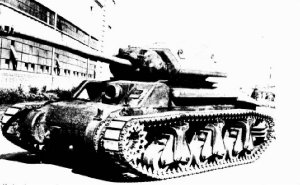Tank procurement for Australia during the Pacific war
Previous -
Index -
Next
The first production of the ACMk1 tanks, known as Sentinel, began in August 1942; Armament one 2pdr gun with 130 rounds, a pair of point303 calibre Vickers machine-guns with 4,250 bullets; Agility 48kph/30mph, trench span 8ft, power unit three Cadillac V-8 petrol motors @ 330bhp, with a range of 320 km’s/200 miles; Armour thickness 25-65mm, crew of five with intercommunications circuit and No19 wireless set, weight 28ton and the maker New South Wales Railway Company Chullora. The ACMk2 was planned to have the new 6pdr (57mm), but supplies of this weapon were needed elsewhere, and to streamline manufacturing details, correct teething problems of operational service and re-address design weaknesses. The low muzzle velocity and curved trajectory 25pdr (87.6mm) was considered for the ACMk3 close support version with an engine built in Australia by General Motors-Holden. The 17pdr (75mm) AT gun was planned for the 31ton ACMk4 and a prototype was tested being the most powerfully armed Western Allied tank in 1943.
The development of Sentinel with the 17pdr gun was similar work done in Britain to mount this new weapon in a turret, whereas the Australian tank was shown to be capable of accepting the larger gun, the British experts had to go and design new hulls to accommodate a larger turret ring, or use the USM4 Sherman. Australia through Lend-Lease purchased US built M3 Lee-Grant medium tanks, with a 37mm gun in a small high-elevated turret but powerful and limited traversing 75mm gun in the side front hull. They filled the ranks of the Australian 1Armoured Division (Maj-Gen Robertson), 3 Armoured Division (Maj-Gen Bridgeford) and Army Tank Brigades. The M3 Light Stuart / Honey, used at Buna and Sanananda, were given to the divisional cavalry reconnaissance regiments of the Light Horse tradition. By June 1942 Australia had a medium tank force of some 467 tanks whose main armament could penetrate the Japanese armour, maximum 26mm, at ranges of 1000 yards and by April 1943 there were 1,672 tanks and a planned 775 AC’s for manufacturing in Australia. In July 1943 future production plans were cancelled and of the sixty-six ACMk1’s fabricated and acquisitioned the RAA used them solely as armoured training vehicles until 1956, as with any Matilda tanks still in service then replaced with the British Centurion.

Conversely the Japanese medium tank could not penetrate the armour of Matilda Infantry tanks supplied from Great Britain and US made M3 mediums except at ranges much less than 1,000yards. As the long range battles in North Africa had already shown this disadvantage made a tank force virtually ineffective. As the threat of invasion receded armoured units, which had been dispersed throughout Australia in the anti-invasion role, were disbanded until by the end of the war only the 4AB remained. This tank brigade formed in early 1943, issued and equipped with modified Matilda Mk2 Infantry Tanks, even an added anti-mine / grenade cover mesh over the engine cover plate and exhaust, was training in Queensland until later that year. Detached formations of this parent outfit fought in Papua-New Guinea, on Bougainville Island and in 1945 at Borneo. The Matildas were also converted to ‘circus equipment’ for specific intended use throughout the South West Pacific war zone. One type developed named a Frog were specially modified with a flamethrower in place of their main armament for burning out bunkers, tunnels, buildings and other strongpoints of the enemy. One troop of Frogs landed with the 2/9AR at Labuan in Brunei Bay, and another troop of Frogs at Balikpapan with the 1AR, the new-named reinforced and re-equipped 1Army Tank Battalion. Other Australian produced circus equipment was the CS Matilda armed with an 3inch (75mm) Howitzer, the Matilda Hedgehog another bunker buster with a piece of weaponry from naval anti-submarine stores.
A spigot mechanism multi-launching 63kg-mortar bombs, in a propelling rack attached to the rear of the tank with a range of about three hundred yards. And the Matilda Dozer, with a disconnectable bulldozer blade fitted to the front hull for clearing away obstacles and the conventional Matilda can be converted to a normal gun tank when required. A troop of Matilda Dozers landed at Balikpapan but the Matilda Hedgehogs sent to Bougainville in 1945 were too late to see action. Although because of the close jungle conditions there were never opportunities for mass armoured manoeuvres and the designed Matilda Infantry tanks rather fought like the mobile monsters reminiscent of advances across the bullet swept muddy trenches in later years of the Great War. The tanks performed other active duties, escorted supplies columns against snipers and ambush, transported wounded riding on top perhaps sitting on the anti-magnetic mesh mine screen over the engine cover to prevent their buttocks from getting burnt. As a consequence the Australian armoured units were organised as self-supporting groups with service & maintenance and local defence auxiliaries included. The slow advances entailed exhausting periods of up to six hours in a closed tank gaining experience in using AFV’s down narrow tracks in support of infantry and were used to cut tracks through the thick jungle to maintain the infantry further on. And were subjected to daily attacks by ambush, a host of obstacles including mines, booby-traps, tank ditches, concealed anti-tank and field artillery guns, in addition to all round rough terrain and the environment.
Previous -
Index -
Next
|

